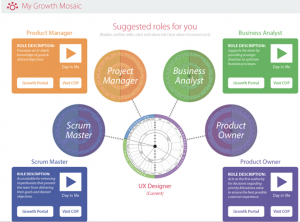Top Agile Roles to Develop in 2019
The challenge many organizations implementing (or have implemented) Agile find early on is that there are a number of critical roles and skills they suddenly require that have not been a part of the organization’s DNA before.
The manner in which the areas of the organization are implementing Agile are structured is significantly different to a traditional organization. Suddenly, there is a key requirement for roles such as ScrumMasters, Release Train Engineers, Product Owners/Managers, Agile Coaches, Portfolio Leaders, Community of Practice Leaders, etc. (referred to as Agile Enablers).
Roles within the senior leadership, management, team leadership, project management and technology teams will, in all likelihood, remain as key roles; however, the skills and behavioral profile of these roles will need to change and, in many instances, be expanded.
The key sets of skills we are looking for in these roles include:
| Skill | Agile Leaders | Agile Enablers | Agile Teams |
| Lean-Agile Mindset | X | X | X |
| Servant Leadership | X | X | X |
| Culture Custodian | X | X | X |
| Customer-Centric | X | X | X |
| Value-Stream Driven | X | X | X |
| Collaboration Mindset | X | X | X |
| Knowledge Transfer | X | X | X |
| Creating a Safe Environment | X | X | X |
| Innovation | X | X | X |
| Continuous Improvement Mindset | X | X | X |
| Quality Focused | X | X | X |
| Team Work | X | X | X |
| Multi-Skilled | X | X | X |
| DevOps | X | X | X |
| Outcomes Driven | X | X | X |
| Flexible | X | X | X |
| Feedback | X | X | X |
| Facilitation | X | X | X |
| Communication | X | X | X |
When determining how best to fill these roles, organizations need to reference their talent acquisition strategy and tactics to decide whether they will be buying, building, bridging or borrowing these skills. The reality is that building and bridging for these skills is the preferred method as it creates sustainability and stability within the organization.
In today’s fast-paced, ever-changing world, knowledge workers have a growth mindset and truly value opportunities to expand their current skills as well as develop new skills. An innovative and modern way of enabling them to do this is through introducing and developing career mosaics and to allow employees to drive their own skills development. This is an example of a career mosaic:
The organization can make use of various learning modalities to support this development (e.g. coaching, on-the-job learning, knowledge transfer, micro-learning, pairing, communities of practice, DoJos, etc.).
In conclusion, enabling a Lean-Agile Mindset in your organization requires new ways of thinking, new ways of attracting and developing talent, new ways of motivating and engaging talent, and most importantly, new ways of creating sustainable organizations.
By Dawn Thiem, VP of Enterprise Business Agility & Operations and Myles Hopkins, Enterprise Business Agility Strategist



Comments